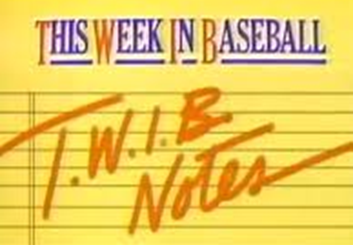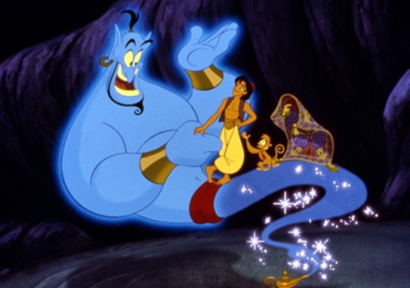Friends of Branded!
Happy Saturday and I hope you had a great week.
In last week’s Top of the Fold I offered up An Ode to Start-Ups b/c I feel nothing is easy and I wanted to tip my hat to the crazy ones (no, I’m not going to use that (awesome) quote from Mr. Steve Jobs again this week).
I enjoy receiving comments each week on the newsletter and whether they’re good, bad, or otherwise, I appreciate the feedback, and suggestions (and that includes the pointing out of my many typos).
One of the comments I received was the inspiration for this week’s TOTF (yes, I’m testing out whether I can make this acronym for Top of the Fold fly…oh like This Week in Baseball’s “TWIB” is so much better?) b/c it suggested I was cheering for the whole industry. How can I cheer for all, when “all” can’t win. I took the comment to suggest I was singing the spiritual song known as “Kumbaya” or even handing out participation trophies for all members of the hospitality industry (or at least that’s how I read it).

I do cheer for the industry and all the good people that comprise it, but don’t mistake my kindness for weakness. There are winners and there are losers (are we still allowed to use the word “losers”, or do we now call them “not winners”?).
At my daughter’s first spring basketball game last Saturday, our team lost by a score of 23 to 10 and the winning team actually had two-on-goals (or whatever you call it when a team scores a basket for the opposing team). Two players on the opposing team got mixed up at which basket they were shooting at, so I feel the score of this first game was really 27 to 6. I share this quick story not b/c I expect anyone to care about a basketball game played by 7 and 8-olds, but to share that one of the kids on my daughter’s team cried after the game b/c she didn’t like losing. I like that kid. She cares and losing sucks.
It made me think of the title of this week’s H^2 and (of course) this famous quote, “sometimes you win, sometimes you lose, sometimes it rains,” from the 1988 American romantic comedy, Bull Durham, staring Kevin Costner, Tim Robbins, and Susan Sarandon (which also ranks 3rd on my all-time list of favorite baseball movies).

Let’s not kid ourselves, there are restaurants that fail. They don’t fail at the level of the urban myth that “90% of restaurants fail in their first year.” That statistic, which is widely repeated, is simply not accurate and has been debunked by more studies than the number of times our ‘rat pack’ has sung Happy Birthday to Schatzy when we gather for dinner. The actual first-year failure rate for restaurants is about 23%, which is similar to other service-based small businesses.
We’re in an economic environment that I believe we can all agree is challenging and where consumer confidence is waning for a variety of reasons, including the uncertainty around international trades rules (which will prove to be particularly damaging to small businesses). But despite this environment, we still, of course, are witnessing winners and losers. I’ll go further and say it’s in environments that are particularly challenging that you really see what separates the winners from the losers.
There was a quote that my mother particularly liked, and she once used at a meeting to the dismay of the people it was directed to and to the utter joy of my father who still regales in the telling of the story of her doing so – “don’t confuse brains with a bull market.” To be clear, I don’t think the restaurant industry is ever or has ever been easy, but as the lines have been blurred and guests have more dining options than ever before, combined with a challenging economic environment and consumer confidence falling, this is a truly difficult market to operate in (maybe not pandemic-tough, but tough all the same).

Think about it, when one of the industry’s favorite and best-performing companies, Chipotle, announces a drop of 0.4% in same-store sales in Q1 2025 (its first quarterly drop since the pandemic), the restaurant industry takes that as a warning sign and an indication that we’re seeing a broader slowdown in consumer spending.
I read an article this week that shared a bevy of well-known and (once) popular restaurant brands that have filed for bankruptcy. I don’t want to throw shade, but I believe its understood that TGI Fridays, Red Lobster, and On the Border Mexican Grill & Cantina are just some of the brands with meaningful unit counts that have filed for Chapter 11 bankruptcy protection.
But this is what I want to hammer home - there are restaurants that are winning and when you dig into how these companies are doing it, a picture of a winning formula starts to emerge. I can attribute the companies that are outperforming their peers (competition) to a combination of strategic execution, market positing and operational adaptability, but if I don’t dig deeper, that’s like saying the New York Knicks beat the Detroit Pistons on Thursday night to win their first round of the NBA playoffs b/c they scored more points (and now the Knicks get to face-off against the defending champions, the Boston Celtics. Following the Knicks dramatic victory, JB congratulated me on the Knicks “winning the JV series and looking forward to our now moving onto playing the Varsity.” Well played, JB, well played. Now let’s get it on!). 😊
You want your restaurant to win? Then let’s focus on what is truly separating the winners from the losers (how many times in this TOTF am I going to use the word “losers”? Will there be a 7th time?).
Guests want value and I’m NOT saying cheap or even inexpensive, I’m saying “value,” which I define as how a guest feels when it’s time to pay the bill? Do they feel they received value for the price of the meal and / or the experience? This isn’t about QSR. It’s about the full spectrum of restaurants from QSR to FSR and everything in between.

You want to know who is winning by showing value? Both YUM Brands and Chili’s are continuing to demonstrate that they offer value their guests.
YUM announced this week that global same-store sales rose by 3% led by Taco Bell (9%) and KFC (2%). The company posted higher revenues despite the challenging environment. Yum Brands! is winning with innovative menu items and value-focused promotions. These offerings are resonating with cost-conscious consumers that are leaning into affordable dining options. But YUM has also invested heavily in digital initiatives and that includes the launch of “Byte by Yum!”, a propriety AI-driven platform aimed at optimizing mobile ordering, kitchen operations and delivery processes. At YUM, digital sales now account for over 50% of total sales, and the company deserves to be recognized for its successful digital transformation.
Chili’s same-store sales rose 31% driven mostly by a 21% increase in year-over-year traffic. As highlighted recently in the TOTF (😊), Chili’s has a second-to-none advertising & marketing strategy where it highlights its value (and arguably the best jingle in the restaurant game), but they also leverage operational improvements including a new kitchen display system that streamlined its workflow and enabled faster ticket times.
I know we’re a people-first industry and then a food & beverage one, but the correlation between the brands that are winning, and their embracement of digital and off-premises solutions is too clear to ignore. Those that have adopted a digital infrastructure are winning in the game of guest engagement and operational efficiency. What’s more important than winning in guest engagement and operational efficiency? I don’t Mrs. Lincoln, other than that, how was the play?

If you’re late to adopt off-premises and mobile technology solutions, you’re losing market share to those that have done just that.
Friends, don’t shoot the messenger, but no matter where you play on the restaurant spectrum, you need to deliver value to your guests. You need a digital and data-driven strategy b/c you need to know your guests. You need to fight to remain relevant and that means menu innovation and I’m sorry not sorry, cultural relevance and if you want to resonate with Gen Z, you need to be purpose-driven.
None of this is easy, but we’re also in an age where the tools available to win in this digital transformation aren’t limited just to Yum Brands! or the biggest players. The democratization of our industry continues and the ability for independents and SMBs to run a comparable digital playbook to operators of all shapes and sizes is available. But being big and having a large unit count doesn’t remotely guaranty safety as some of the names I highlighted above should tell you. Delivering value to your guests and embracing the digital tools that are readily available is now table-stakes.
Yes, I’m cheering for our industry and everyone in it, but there will be winners and losers (#7) and Branded can only help and work with those that understand what it takes to win as the digital transformation continues to roll forward (and gain momentum).
It takes a village.



